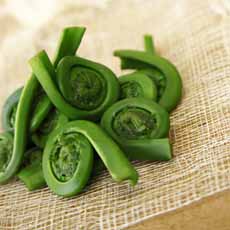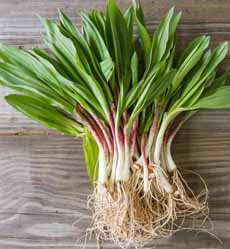TIP OF THE DAY: Celebrate Spring Vegetables
 [1] Puréed cauliflower and peas topped with a bouquet of colorful, lightly-steamed vegetables (photo © Maison Kayser).
|
June 17th is National Eat All Your Veggies Day. No matter what the weather is like in your neck of the woods, spring began this morning at 7:02. So, today’s tip is: Cook something that celebrates springtime.
We vote for something colorful. Doesn’t this dish just burst with springtime? You can make it with the ingredients in your fridge! The concept is by Chef Taleb Daher of Maison Kayser, Paris: Puréed cauliflower and peas (you can use any vegetable) topped with a bouquet of color: beets, broccoli florets, carrots, chives, and baby radishes. Or, prepare a recipe with spring vegetables: low in calories, and high in nutrients. Most of this delectable group are fleeting, available only for a few months a year; so enjoy them while you can. One of the most memorable dishes in our lifetime of fancy eating was a simple spring sauté of asparagus, garlic scapes, morels and nettles. Artichokes: Spring artichokes are larger, delivering more flesh on each leaf. It couldn’t be easier to steam them and dip the luscious leaves in a vinaigrette or melted butter; we actually enjoy them plain. Check out the different types of artichokes. Asparagus: Domestic asparagus begins to appear in March; the season runs through June. We can’t get enough of the delicious spears. Here are 12 easy asparagus recipes. Cardoons: This specialty item, also called artichoke thistle, is part of the same species as the globe artichoke. Not surprisingly, it tastes a lot like artichoke, and was popular among the ancient Greeks, Persians, and Romans. Try braising them in verjus as a side to grilled salmon. Fava Beans: Fava beans, also known as broad beans and horse beans, are another sign of spring. They originated in ancient Egypt and were the only bean known to Europeans until the discovery of America. Unshelled, they look like lima beans, but have a more buttery texture and slightly bitter, appealingly nutty flavor. Enjoy them as a side, in soups, or in stews. As you may recall, Hannibal Lechter enjoyed his with liver and a nice Chianti. Fiddleheads: Also called fiddlehead ferns, these young wild ferns are not cultivated but foraged (photo #2). The top unfurls as the fern matures, but when young it resembles the curled ornamentation (scroll) at the top of a violin or other stringed instrument. Fiddleheads have been popular in Northern France since the Middle Ages, and are found in Asian and Native American cuisines. They have an asparagus-like texture and flavor with a hint of nuttiness. |
|
|
Garlic Scapes: Garlic scapes, also known as green garlic, are the curling tops of immature garlic plants; they look similar to the tops of scallions (green onions). They were usually cut off of the plant and discarded, since leaving them on only limits the growth of the garlic bulb. But some garlic farmers have been convinced to bring the scapes to market. With a delicate garlic flavor, they are a must-try spring treat. |
||
|
Morels: Morels have not yet been cultivated successfully, so they are foraged in the wild in the spring. While they can be a chore to clean, the flavor is intense and exciting. Here’s everything you need to know about morel mushrooms.
Nettles: Nettles, or stinging nettles, may not sound like culinary delight. They grow as garden weeds. But they are delicious, high in protein and lose their sting after 30 seconds of cooking. Sauté them as a side or add them to soups, stews, and pasta dishes. Look for them at farmers’ markets, or ask where you can forage for them in your area. Pea Greens: Pea greens are sold in big bunches of bright green vines with leaves, but don’t worry: That big bunch cooks down to about 10% of its raw volume. Look for pea greens in farmers’ markets or Asian markets. They wilt very quickly and need to be cooked within a day or two: simply sautéed in olive oil. Add some browned garlic or shallots and finish with a splash of lemon juice. Add raw pea greens to soups or stir-fries. |
|
|
|
Peas: As much as frozen peas are a good stand-in year round, there’s nothing like fresh spring peas, also known as garden peas and English peas. Steam them lightly for a real treat or purée them into a heavenly soup. Ramps: Ramps, also called wild leeks, are a wild onion native to North America (photo #3). The bulb resembles that of a scallion, but the plant has beautiful broad leaves with burgundy color at the base. The flavor and aroma of are a combination of onions and garlic. As such, they have an almost universal utility: in casseroles, potato dishes (delicious with fried potatoes), rice dishes, scrambled eggs, and soups. They can be used raw or cooked in any recipe calling for scallions or leeks. Rhubarb: Rhubarb is often thought of as a fruit since it’s made in sweet preparations. But the giveaway is that it looks like celery. Make a rhubarb or strawberry rhubarb pie, rhubarb ice cream, a rhubarb sauce for fish, pudding with rhubarb topping or our grandmother’s favorite, stewed rhubarb. Sweet Onions: Sweet onion varieties are plentiful in the spring and beckon to onion lovers to enjoy them raw: in salads, on sandwiches, as a general garnish. What about spring onions? Spring onions are simply regular onions that farmers pull from the field in spring to thin the rows. All of these lovely spring vegetables will add spark to your table from now until the end of spring. Be sure to enjoy them while you can. CHECK OUT WHAT’S HAPPENING ON OUR HOME PAGE, THENIBBLE.COM. |
||




